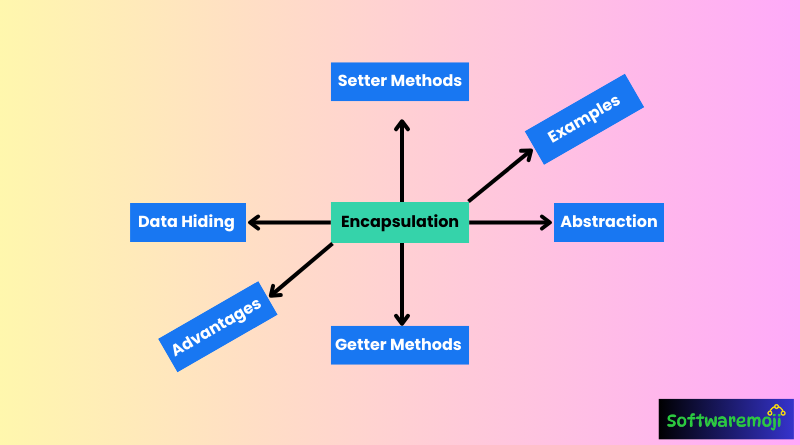
👉Encapsulation in Java:
- Encapsulation in Java is a core OOP principle that binds data and code together as a single unit.
- Java Encapsulation helps to protect data from unauthorized access by using private access modifiers.
- By using encapsulation, Java developers can control how data is accessed or modified through getter and setter methods.
- Encapsulation improves code maintainability and flexibility in large-scale Java applications.
- Encapsulated classes in Java promote modularity and better data integrity.
- In Java, encapsulation hides the internal implementation details from the outside world.
- Encapsulation in Java ensures that only the intended data is exposed to the user, improving security.
- Using encapsulation in Java reduces the risk of accidental data modification and enhances code reliability.
- Encapsulation enables Java developers to make changes to the code internally without affecting other parts of the program.
- Mastering Java encapsulation is essential for writing clean, reusable, and object-oriented code.
👉What is Encapsulation in Java?
Encapsulation in Java is a fundamental Object-Oriented Programming (OOP) concept that involves bundling data (variables) and methods (functions) into a single unit called a class. It restricts direct access to the internal data of a class and allows modification only through controlled methods.
This feature enhances data security, maintainability, and reusability. It also helps in preventing unauthorized access, making Java applications more robust.
👉Why is Encapsulation Important?
Encapsulation plays a crucial role in Java development. Some key benefits include:
✔ Data Hiding: Prevents direct access to class members.
✔ Improved Security: Sensitive data is protected from unauthorized modifications.
✔ Better Maintainability: Code is easier to update and scale.
✔ Enhanced Flexibility: Allows controlled access through getter and setter methods.
👉Encapsulation in Java with Example:
Let’s consider a Bank Account class where we encapsulate account details.
javaclass Account {
private int accountNumber;
private double accountBalance;
// Getter method to retrieve balance
public double getBalance() {
return accountBalance;
}
// Setter method to deposit money
public void deposit(double amount) {
if (amount > 0) {
accountBalance += amount;
} else {
System.out.println("Invalid deposit amount!");
}
}
}
public class BankApp {
public static void main(String[] args) {
Account myAccount = new Account();
myAccount.deposit(1000);
System.out.println("Current Balance: " + myAccount.getBalance());
}
}
👉Explanation:
- The accountNumber and accountBalance variables are declared private, preventing direct modification from outside the class.
- The getter method
getBalance()allows controlled access to account balance. - The setter method
deposit()ensures only valid amounts are deposited.
👉Data Hiding vs. Encapsulation:
Though closely related, Encapsulation and Data Hiding are different concepts:
| Feature | Encapsulation | Data Hiding |
|---|---|---|
| Definition | Bundling data and methods together | Restricting access to class members |
| Purpose | Improves modularity and maintainability | Enhances security |
| Access | Achieved using getters and setters | Achieved using private/protected access modifiers |
👉Encapsulation with Getter and Setter Methods:
Encapsulation uses getter and setter methods to access and modify private variables.
Example:
javaclass Student {
private String name;
// Getter method
public String getName() {
return name;
}
// Setter method
public void setName(String newName) {
this.name = newName;
}
}
public class Main {
public static void main(String[] args) {
Student s = new Student();
s.setName("John");
System.out.println("Student Name: " + s.getName());
}
}
👉Key Takeaways:
- Getter Methods → Retrieve variable values
- Setter Methods → Modify variable values
👉Encapsulation vs. Abstraction:
Many developers confuse Encapsulation and Abstraction. Here’s how they differ:
| Feature | Encapsulation | Abstraction |
|---|---|---|
| Definition | Hides internal data and ensures controlled access | Hides implementation details and shows only necessary information |
| Focus | How functionality is implemented | What functionality is provided |
| Example | Wrapping data with getters and setters | Abstract classes and interfaces |
👉Example of Abstraction in Java:
javaabstract class Car {
abstract void startEngine();
}
class Tesla extends Car {
void startEngine() {
System.out.println("Tesla engine started!");
}
}
Here, Car is an abstract class providing a generic structure, while Tesla implements the behavior.
👉Advantages of Encapsulation in Java:
✔ Prevents unauthorized access by restricting variable access.
✔ Increases security by hiding sensitive data.
✔ Improves code maintainability by reducing dependencies.
✔ Enhances modularity and makes debugging easier.
👉Final Thoughts:-
Encapsulation in Java is a key OOP principle that enhances security, maintainability, and reusability. By using private variables and getter/setter methods, developers can control data access while keeping their code modular and scalable.
Would you like more Java tutorials? Drop your queries in the comments! 🚀
